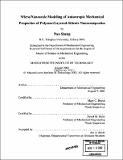| dc.contributor.advisor | Mary C. Boyce and David M. Parks. | en_US |
| dc.contributor.author | Sheng, Nuo, 1977- | en_US |
| dc.contributor.other | Massachusetts Institute of Technology. Dept. of Mechanical Engineering. | en_US |
| dc.date.accessioned | 2007-01-09T19:01:48Z | |
| dc.date.available | 2007-01-09T19:01:48Z | |
| dc.date.copyright | 2002 | en_US |
| dc.date.issued | 2002 | en_US |
| dc.identifier.uri | http://hdl.handle.net/1721.1/28257 | |
| dc.description | Thesis (S.M.)--Massachusetts Institute of Technology, Dept. of Mechanical Engineering, 2002. | en_US |
| dc.description | Includes bibliographical references (leaves 123-125). | en_US |
| dc.description.abstract | Polymer nano-clay composites have been observed to exhibit dramatic enhancements in mechanical properties with relatively low filler loadings (1-4 percent volume fraction). These property enhancements have been speculated to be a result of the change in polymer morphology and properties within the polymer/particle interfacial regions, due to the nanometer length scale and the large interface area/unit volume of the nanoparticles. In this work, the potential contribution of composite-level effects on the observed enhancements is explored. Two-dimensional models of various representative volume elements (RVEs) of the underlying structure of the polymer nano-clay composite are constructed. These models are characterized by clay particle volume fraction and micro/nano scale morphological features such as clay particle aspect ratio (length/thickness, L/t), clay particle distribution (random vs. regular patterns) and clay particle orientation distribution. Macroscopic moduli of these RVEs are predicted as a function of these geometrical parameters as well as particle and matrix stiffness parameters through FEM simulations. Effective properties of intercalated clay particles have been estimated in terms of characteristic clay structural parameters (interlayer spacing and number of layers), with additional information from molecular dynamics simulations of silicate layer stiffness. The predictions of macroscopic stiffness from these two-dimensional micromechanical models, based on structure-dependent particle volume fraction and properties, are consistent with experimental observations. Furthermore, studies of the local stress/strain fields show that the stiffness enhancement comes through the efficient load transfer mechanism in the high aspect ratio fillers, modulated by the strain shielding effect in the matrix. These results suggest that physically-based composite level interpretations may explain the stiffness enhancement mechanism of polymer nanocomposites to a large degree. The adopted methodology offers promise for study of related properties in polymer/layered-silicate nanocomposites. | en_US |
| dc.description.statementofresponsibility | by Nuo Sheng. | en_US |
| dc.format.extent | 125 leaves | en_US |
| dc.format.extent | 22137256 bytes | |
| dc.format.extent | 22139257 bytes | |
| dc.format.mimetype | application/pdf | |
| dc.format.mimetype | application/pdf | |
| dc.language.iso | eng | en_US |
| dc.publisher | Massachusetts Institute of Technology | en_US |
| dc.rights | M.I.T. theses are protected by copyright. They may be viewed from this source for any purpose, but reproduction or distribution in any format is prohibited without written permission. See provided URL for inquiries about permission. | en_US |
| dc.rights.uri | http://dspace.mit.edu/handle/1721.1/28257 | en_US |
| dc.rights.uri | http://dspace.mit.edu/handle/1721.1/7582 | |
| dc.subject | Mechanical Engineering. | en_US |
| dc.title | Micro/nanoscale modeling of anisotropic mechanical properties of polymer/layered-silicate nanocomposites | en_US |
| dc.type | Thesis | en_US |
| dc.description.degree | S.M. | en_US |
| dc.contributor.department | Massachusetts Institute of Technology. Department of Mechanical Engineering | en_US |
| dc.identifier.oclc | 51927739 | en_US |
